2018: My year in music
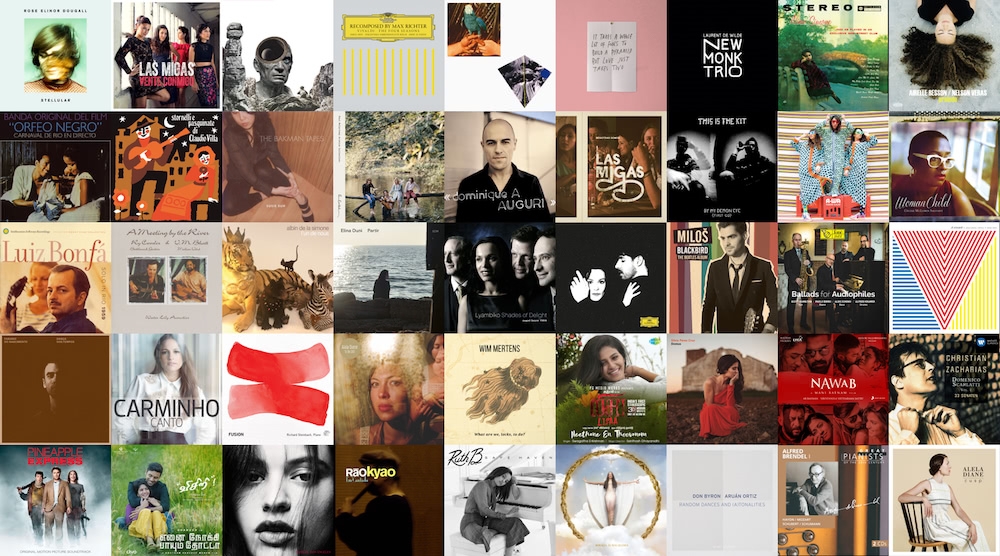 Montage
Montage
When I shared a list of my favourite songs from 2016, I wasn’t sure if it was going to be a one-off exercise or if I’d be able to repeat it every year. Fortunately there has been no dearth of good music and this year’s selection, like the years before, spans multiple genres and languages.
Just like in 2017, I heard music exclusively over streaming. In October this year, I switched to Apple Music. I still prefer Spotify, especially on macOS1 but in the end a streaming service is only as good as the size of its catalog and Spotify has been falling behind - especially when it comes to music from India.2
Back in the day when cassettes were the dominant format, my biggest anxiety was discovering that the quality of sound has deteriorated due to the tape wearing down. My personal equivalent in the streaming world is songs disappearing because the licensing deal with the record label expired in your country. You wake up one morning with a tune stuck in your head only to find the song is no longer playable. Both Apple Music and Spotify at least still show the song in your playlist. There’d be nothing more sinister than for it to disappear from your library without a trace.
The other thing that bothers me about streaming services is artists being available exclusively on one platform. This hasn’t affected me personally yet as only mainstream music sees this kind of deal-making and eventually everything does come on all major platforms, but I fear that it’s only a matter of time before streaming services also become record labels and start signing artists up and restrict them to only their platform. This already happens today with video content exclusive to Netflix, Amazon Prime etc.3
These are minor drawbacks compared to the sheer variety of music I’ve been able to enjoy each day. It’s exhilarating to have instant access to nearly entire musical output of human race.
Finally, a reminder that these are tracks that I discovered and enjoyed in 2018. The date of their release has no bearing on their inclusion in this list.
Here is the playlist:
| Colour of Water: Rose Elinor Dougall | |
|---|---|
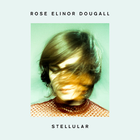 YouTube |
The electric guitar opening draws you in, the synths, the baseline, the drums, Rose Elinor’s voice and just the overall energy and dynamism of the song keeps you hooked. |
| Calma: Las Migas | |
 YouTube |
Love the feeling of ebb and flow the guitars create in the beginning - like being adrift in a calm river. Plus the powerful vocals and fiddle ending. |
| Nobakitani: Kikagaku Moyo | |
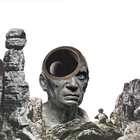 YouTube |
A Japanese psychedelic rock number that incorporates Sitar rather beautifully. |
| Recomposed by Max Richter: Vivaldi, The Four Seasons: Spring 1: By Max Richter - Max Richter, Daniel Hope, Konzerthaus Kammerorchester Berlin & Andre de Ridder | |
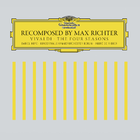 YouTube |
A fine example of how to make something that’s already close to perfect even better. Max Richter’s take on Vivaldi sounds very familiar and very new at the same time. |
| Are You Serious: Andrew Bird | |
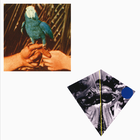 YouTube |
Earlier this year, I left my cushy corporate job for a new gig at a startup. “Are you serious?” was therefore my personal refrain for quite some time this year. |
| Bucket & the Rag: You Raskal You | |
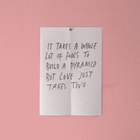 YouTube |
Poignant lyrics. Quirky music video. An unexpectedly cheerful jazzy ending. |
| Misterioso: Laurent de Wilde | |
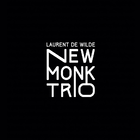 YouTube |
Some fine jazz piano playing. The central theme (around 0:26 mark) has the player moving up and down the scale which for some reason reminds me of boss-level in a video game - think stage 4 in any of the worlds in Super Mario Bros. |
| Love Me or Leave Me: Nina Simone | |
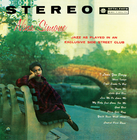 YouTube |
Initially I had come across a remix of this track that caused me to look up the original, which to my ears sounds a lot better. It’s remarkable how contemporary Nina Simone sounds, especially given that this track is from her 1958 debut album. That said, the original source material that Nina drew from dates back to 1928! |
| Neige: Airelle Besson & Nelson Veras | |
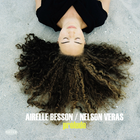 YouTube |
I have a soft spot for pieces that keep thing simple. This one features some inspired trumpet playing to a guitar accompaniment. |
| Manha de Carnaval / Eyridice: Elizete Cardoso & Luis Bonfá | |
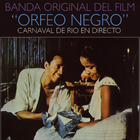 YouTube |
A hauntingly beautiful song. |
| Claudio Villa a mezza voce (Stornelli amorosi - Parte I): Claudio Villa | |
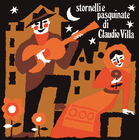 YouTube |
Claudio Villa’s voice is uplifiting. This is one of the four songs on this album in this style. The other two are sung in a fuller voice. |
| I Do: Susie Suh | |
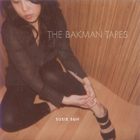 YouTube |
Intentionally left blank as an exercise for the listener. |
| Love Is Strange (2018 Remaster): Paul McCartney & Wings | |
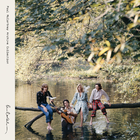 YouTube |
More than a third of this song is a long instrumental intro. Paul McCartney, when we do hear him, is instantly recognisable and at the time of this 1971 recording, still very much on top of his game. |
| Les enfants du pirée: Dominique A | |
 YouTube |
The opening of this song sounded very familiar. I realised that a cookware company in India had used the opening bars for their jingle. This one is a cover of the original from a 1960 Greek film. |
| Me Mueve el Aire: Las Migas | |
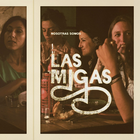 YouTube |
A mí me mueve el aire, el aire me mueve a mí |
| By My Demon Eye (First Go): This Is the Kit | |
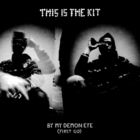 YouTube |
Intentionally left blank as an exercise for the listener. |
| Ya Shaifin al Malih: Awa | |
 YouTube |
Three-sister band from Israel that blends Yemenite traditional music with modern sounds. |
| John Henry: Cécile McLorin Salvant | |
 YouTube |
I am featuring a track from this album for the third time in a row. This is one of the more playful song on the album but it still showcases Cécile McLorin Salvant’s impressive vocal range. Aaron Diehl’s staccato piano playing provides the perfect accompaniment. |
| Sambolero: Luiz Bonfá | |
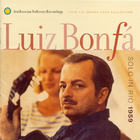 YouTube |
Just a guitar and Luiz Bonfá humming. |
| Isa Lei: Ry Cooder & Pandit Vishwa Mohan Bhatt | |
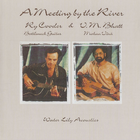 YouTube |
Back in 1993 when Vishwa Mohan Bhatt won the Grammy, I heard about it in news in India. However, it wasn’t very clear what exactly he had been awarded the Grammy for. I assumed it was some kind of ‘Lifetime achievement’ award for his invention of Mohan Veena. It sounds ridiculous to think how much effort it took back then (before Internet and Wikipedia) to look up things like these, especially after they had drifted out of the news cycle. It was only when I heard the Mohan Veena interlude in a Tamil song some 4 or 5 years later, did I realise what it sounded like. It made me very happy to have stumbled upon the album that got him the Grammy. This is my favourite track from the album. Ry Cooder’s slide guitar and Mohan veena blend beautifuly to create a calm atmosphere. |
| Le grand amour: Albin de la Simone | |
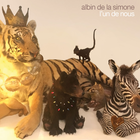 YouTube |
Included for Albin de la Simone’s warm, soothing voice. |
| Oyfn Veg: Elina Duni | |
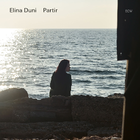 YouTube |
A beautiful, minimalist rendition of a yiddish lullaby about a boy who wants to become a bird to give company to a leafless wintry tree because all the other birds have fled to warmer climes leaving it alone. |
| Malaika: Lyambiko | |
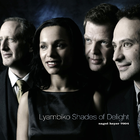 YouTube |
I sometimes wonder if composers in India had nobler intentions for lifting tunes so blatantly - such as exposing the Indian masses to music from all over the world. Perhaps, in there minds they were merely recording a cover. Anyway, I heard Malaika first in its Hindi avatar. The original Swahili version’s authorship is a bit murky and dates back to 1945. It became popular in the West in the 1980s thanks to the German band Boney M. This particular cover of Maliaka couldn’t be more distant from the disco days of Boney M and exudes refinement. |
| O Cessate Di Piagarmi (Arr. Voice & Electric Guitar): By Alessandro Scarlatti - Nora Fischer & Marnix Dorrestein | |
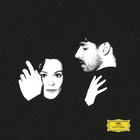 YouTube |
I love modern reinterpretations of classical works, especially when they are done this well. This is what the original material would typically sound like. This one uses electric guitar in place of a piano. Both the vocals and the electric guitar are brilliant. |
| Lucy In the Sky With Diamonds (feat. Anoushka Shankar): Miloš Karadaglić | |
 YouTube |
I can see why Anoushka Shankar would be a natural choice for playing Sitar in a Beatles tribute album but I am surprised by the choice of the song. The original Lucy in the sky with diamonds has no Sitar. It does have a lose Indian connection becuase of the use of Tanpura in the background and perhaps that alone was enough. In any case, this particular rendition borrows only loosely from the source and Miloš and Anoushka truly make it their own. |
| The Shadow of Your Smile: Scott Hamilton | |
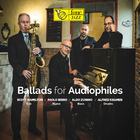 YouTube |
This recording has an intimate feel redolent of the hey days of Blue Note records4. |
| These Days: St. Vincent | |
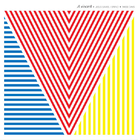 YouTube |
Intentionally left blank as an exercise for the listener. |
| Forro Brasil (feat. Airto Moreira): Fabiano do Nascimento | |
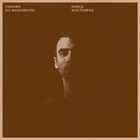 YouTube |
From 0 to foot-tapping in 10 seconds. |
| A Ponte: Carminho | |
 YouTube |
Modern Fado at its traditional best. |
| The Köln Concert: Part 2c: Richard Steinbach | |
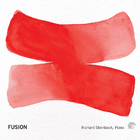 YouTube |
I had read about Köln Concert in Tim Hartford’s book, Messy5. Apparently the original concert had everything going against it - a tired performer and the wrong kind of piano. The Wikipedia page has more details:
Despite these odds, Keith Jarrett gave a sublime performance that is both critically acclaimed and commercially successful. He transcribed this 1975 performance in 1990, which has allowed others recordings of this work to become available. While the original is a must hear, I love this recording by Richard Steinbach as it showcases what’s possible on a modern, grand piano. It sounds a lot fuller especially in the in lower registers. Despite being a studio recording under more controlled circumstances, it retains the verve and warmth of the original. |
| Lady Divine: Alela Diane | |
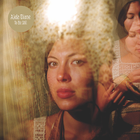 YouTube |
I had discovered Alela Diane 11 years ago when Apple had featured another song (Dry Grass and Shadows) from this album (To Be Still) as part of their free weekly ‘Song of the week’ giveaway. Over the years I’ve come to appreciate her voice and whimsical (if somewhat dark) lyrics even more: When the day, when the day falls to the light,at the end of the end of my time, I fall, to the dark, take the bones off my back. And I chant, to the black, you were my lady divine. Cause my children, are in hiding, mortar and pestal they grind. |
| Loosening the Ropes: By Wim Mertens - Wim Mertens | |
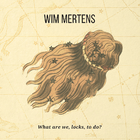 YouTube |
Wim Mertens glorious voice soaring over piano (which he plays himself). Apparently, none of the songs in the album this track is from (What Are We, Locks, To Do?), have lyrics. A Dutch review I read summed it up nicely: Still as part of a larger, diverse playlist, I’d keep it. |
| Neethane En Thoovanam (From “Lisaa”): Swagatha S. Krishnan & Santhosh Dhayanidhi | |
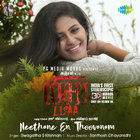 YouTube |
This song evokes the idyll of rural hill stations of South India. Swagatha’s voice in this track reminded me of Bombay Jayashree a lot. |
| No Hay Tanto Pan: Silvia Pérez Cruz | |
 YouTube |
Silvia Pérez Cruz’s voice in this song gives me goosebumps. ‘No Hay Tanto Pan’ or ‘There is not enough bread’ featured in a 2016 Spanish film (Cerca de tu casa) about the effect of the 2007 economic crises on families in Spain. Silvia Pérez also had a leading role in the film! |
| Bhaga Bhaga: A. R. Rahman & Shakthisree Gopalan | |
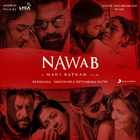 YouTube |
The bigger hit from this album was Neeli Kanumallo (Mazhai Kuruvi if you prefer Tamil) but for me this song stood out for its unusual structure. |
| 33 Sonaten Für Klavier: Sonate K. 380 (L 23) E-Dur: Andante Commodo: By Domenico Scarlatti - Christian Zacharias | |
 YouTube |
There is a passage with shops, cafés etc. in Centraal Station that runs between the South and North exit. At night, they pipe classical music (usually harpsichord works) over the PA system - purportedly to discourage teenagers from loitering. One night they were playing a recording of Scarletti piano sonatas and I immediately fell in love with this one. In fact, I might have lingered on a little longer than I would’ve. Now what are they to do about 40-somethings that loiter because they have classical music on? |
| Bird’s Lament: Moondog & The London Saxophonic | |
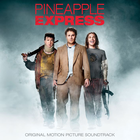 YouTube |
Brilliant counterpoint between tenor and baritone Saxophones (I am guessing the instruments based on sheet music I found on the internet: this is where I miss physical media with liner notes) - like two birds quibbling over something early in them morning. |
| Visiri (From “Enai Noki Paayum Thota”): Darbuka Siva, Sid Sriram & Shashaa Tirupati | |
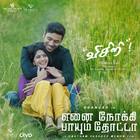 YouTube |
Tamil film music at its genre defying best. |
| Si Tú Supieras Compañero (feat. Raül Refree): ROSALÍA | |
 YouTube |
Rosalia was my artist of the year. She has a beautiful voice, tremendous vocal range and excellent control. Listen to De Plata from the same album to get a sense of her vocal talent. This song is rooted in traditional Flaminco but has a dissonant string section in the end evocative of mourners wailing. |
| A Noite Gosta de Mim: Rão Kyao | |
 YouTube |
Fado is normally sung to the accompaniment of Portuguese guitar(s). To hear it performed with bamboo flute is quite unusual. Replacing the sonorous, steely sound of the acoustic guitar with soft, sinusoidal sound of flute alters the texture of the music entirely and yet it’s distinctly Fado. |
| Lost Boy: Ruth B. | |
 YouTube |
Sublime lyrics and singing. |
| MALAMENTE (Cap.1: Augurio): ROSALÍA | |
 YouTube |
This is from Rosalía’s 2018 Album El Mal Querer. It was a difficult pick because pretty much the entire album is a heady blend of flemenco, pop, trap, electronic and hip-hop. The music video for this song is quite brilliant and is full of visual metaphors for all things that would go badly (badly being the literal translation of ‘Malamente’) - from bullfighters on bikes to a person in monk-like robes on a skateboard riddled with spikes. |
| Black and Tan Fantasy: Don Byron & Aruan Ortiz | |
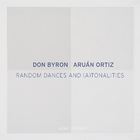 YouTube |
This grows on you. One morning I woke up convinced that it had been playing in the house. It was a few moments later. |
| Piano Sonata in E Minor, H. XVI No. 34: I. Presto: By Franz Joseph Haydn - Alfred Brendel | |
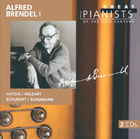 YouTube |
Only a handful of the 60 odd Haydn piano sonatas are in minor keys. The opening movement of each of them draws you in the moment the first bars are played. This Alfred Brendel recording of the E-Minor sonata is magical. |
| Ether & Wood: Alela Diane | |
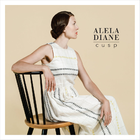 YouTube |
This is the sort of song that makes me feel like I am standing alone in an expansive landscape - think American prairies - with a storm brewing far in the distance. |
| Congratulations and Condolences: Allison Miller’s Boom Tic Boom | |
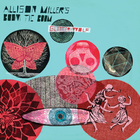 YouTube |
A complex piece that is rich, full and bursting with energy. |
| Wo Ladki: Arijit Singh | |
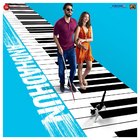 YouTube |
A Bollywood song built around a moderately complex piano piece is rare6. Arjit Singh’s voice put any doubts I might have had about incorporating this into my year-end retrospective to rest. |
Two things I sorely miss in Apple music - ability to sort playlists by album/artist/year of release etc. and the ability to search within a playlist.↩︎
And I am not talking obscure long tail Indian music but mainstream Bollywood fare - looks like they are missing key labels like T-Series which leaves them without a lot of new releases. Hopefully, this changes when they launch their service in India.↩︎
On the other hand the production costs for producing an album can be vastly lower than film or TV so in such a world, at least a small number of musicians might choose to self publish and make their works available across all platforms. I am not convinced about this argument as there are a lot of capital intensive activities outside of production (promotion, touring etc.) which the artists need a label for. Much like the lower barrier to entry for writers with Amazon allowing self-publishing, hasn’t eliminated publishers. Worse, artists that go without a label could decide to restrict the availability to LPs or digital downloads on their website leaving us to contend with not just different streaming providers but also numerous small artists.↩︎
This documentary on the visual language of Blue Note record covers is worth a watch. Via jnack.com.↩︎
I racked my brain for other examples and the closest I could come up with is the theme song of the 1985 movie Meri Jung. That said, I am woefully out of touch with Bollywood for the past few years and down to 1 or 2 movies a year, so there might more recent works I have no idea about.↩︎
Pictures from a foggy day in Amsterdam
On foggy days, some quarters of Amsterdam remind you of fairy tales while others feel like you are wandering through a post apocalyptic dystopia. Some pictures from a cold, foggy day last week that try to capture both ends of the spectrum and something in between:
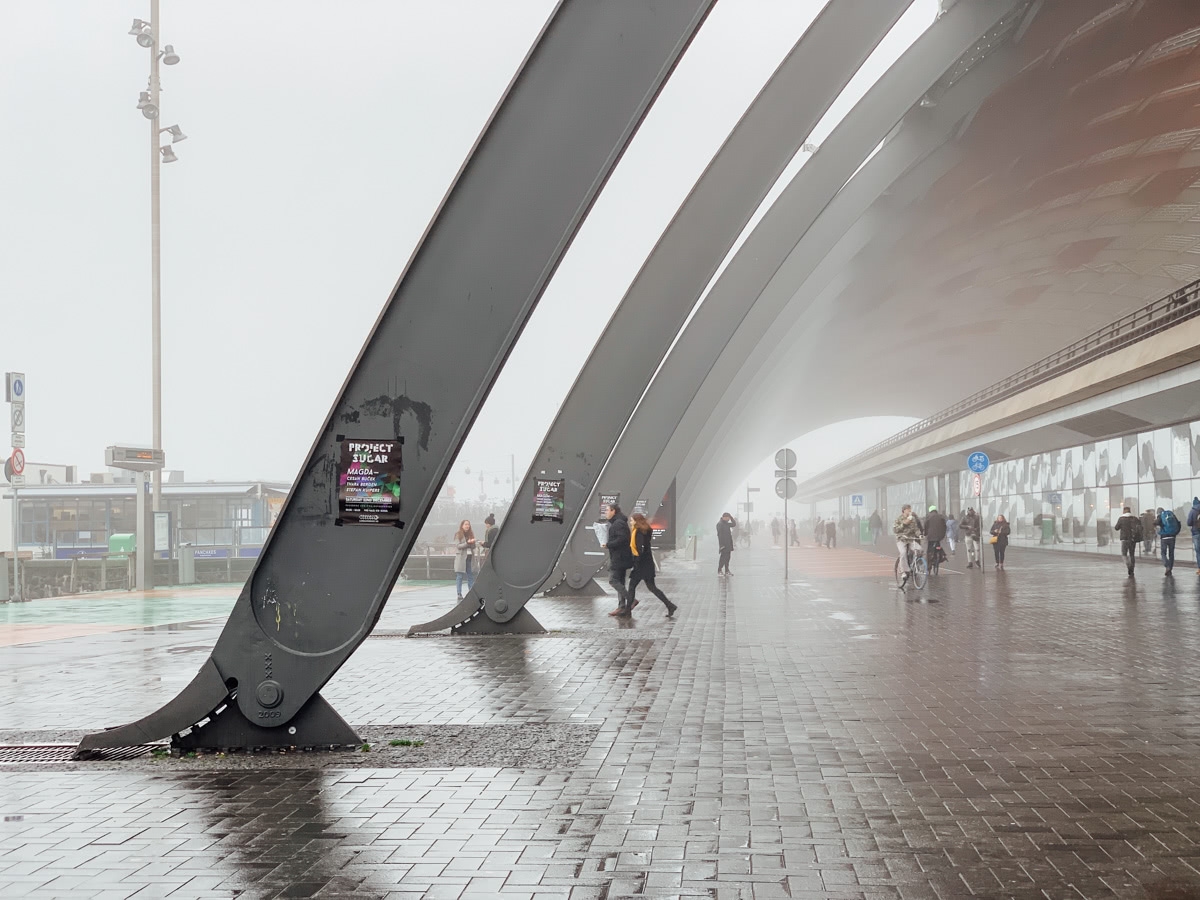 Centraal Station
Centraal Station
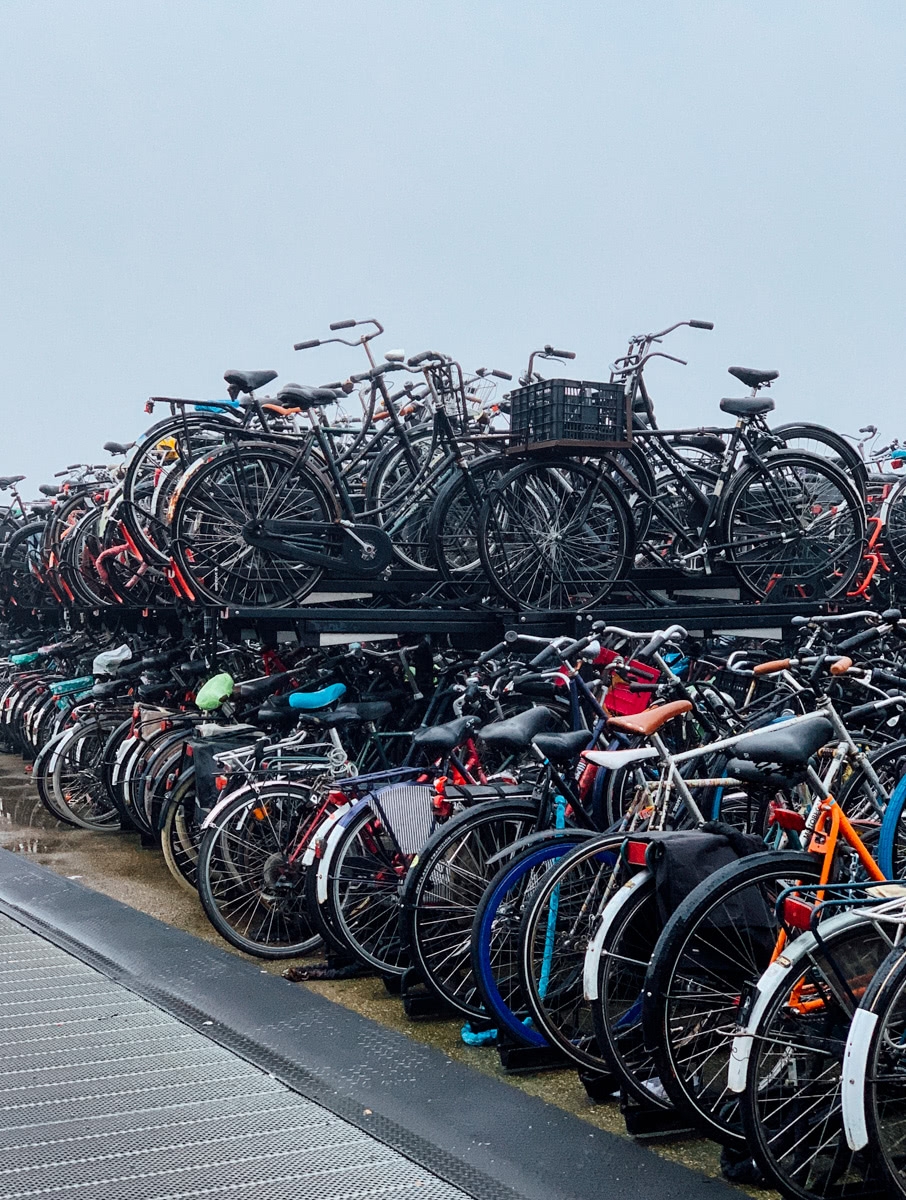 Cycle parking
Cycle parking
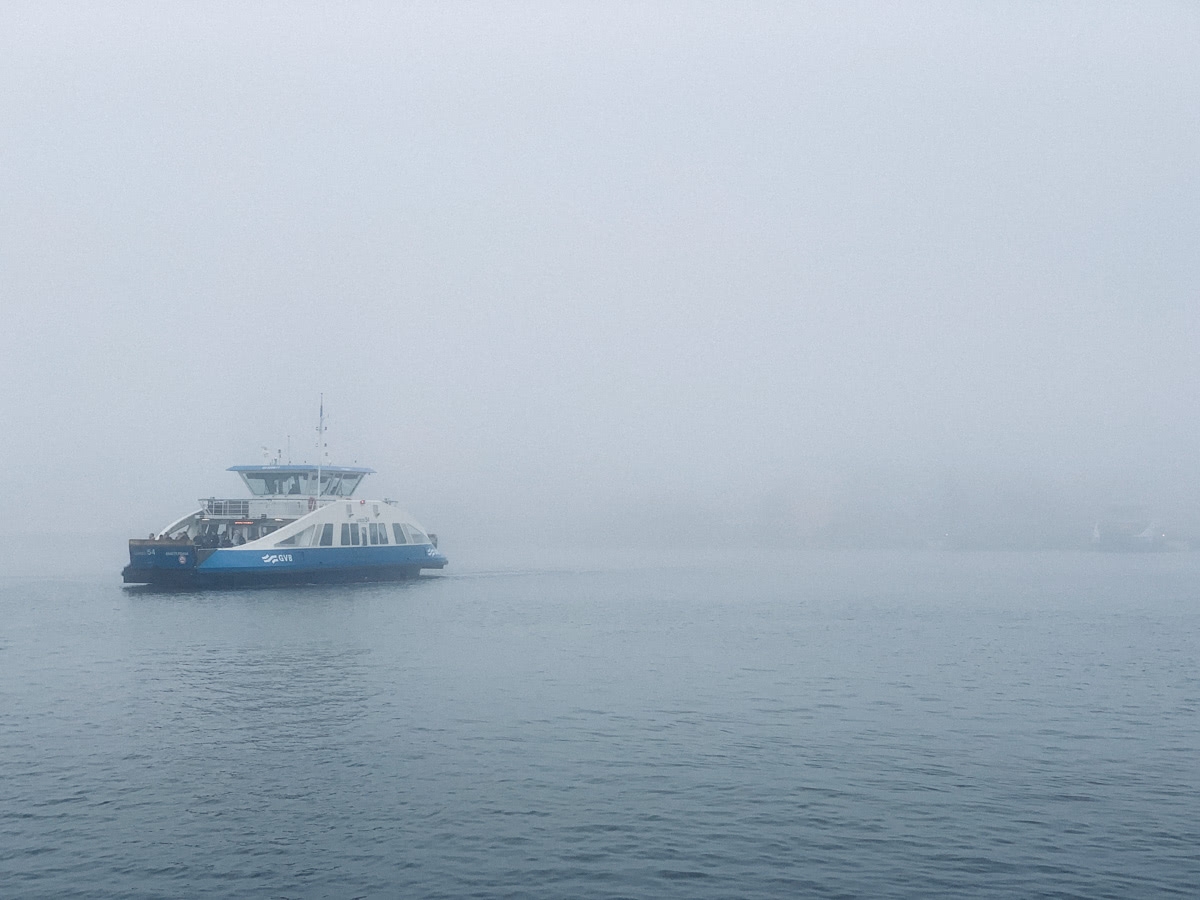 Ferries crossing the Ij
Ferries crossing the Ij
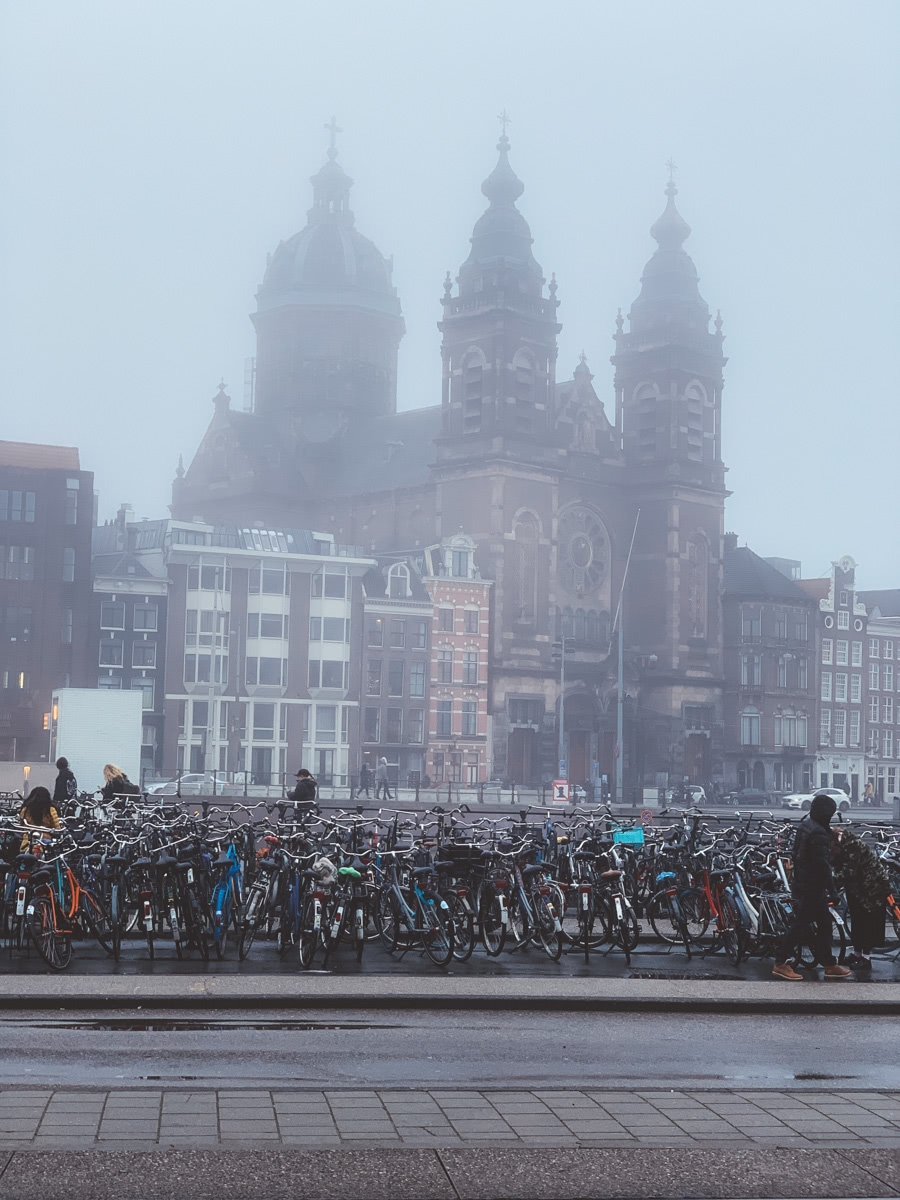 St. Nicholas Basilica
St. Nicholas Basilica
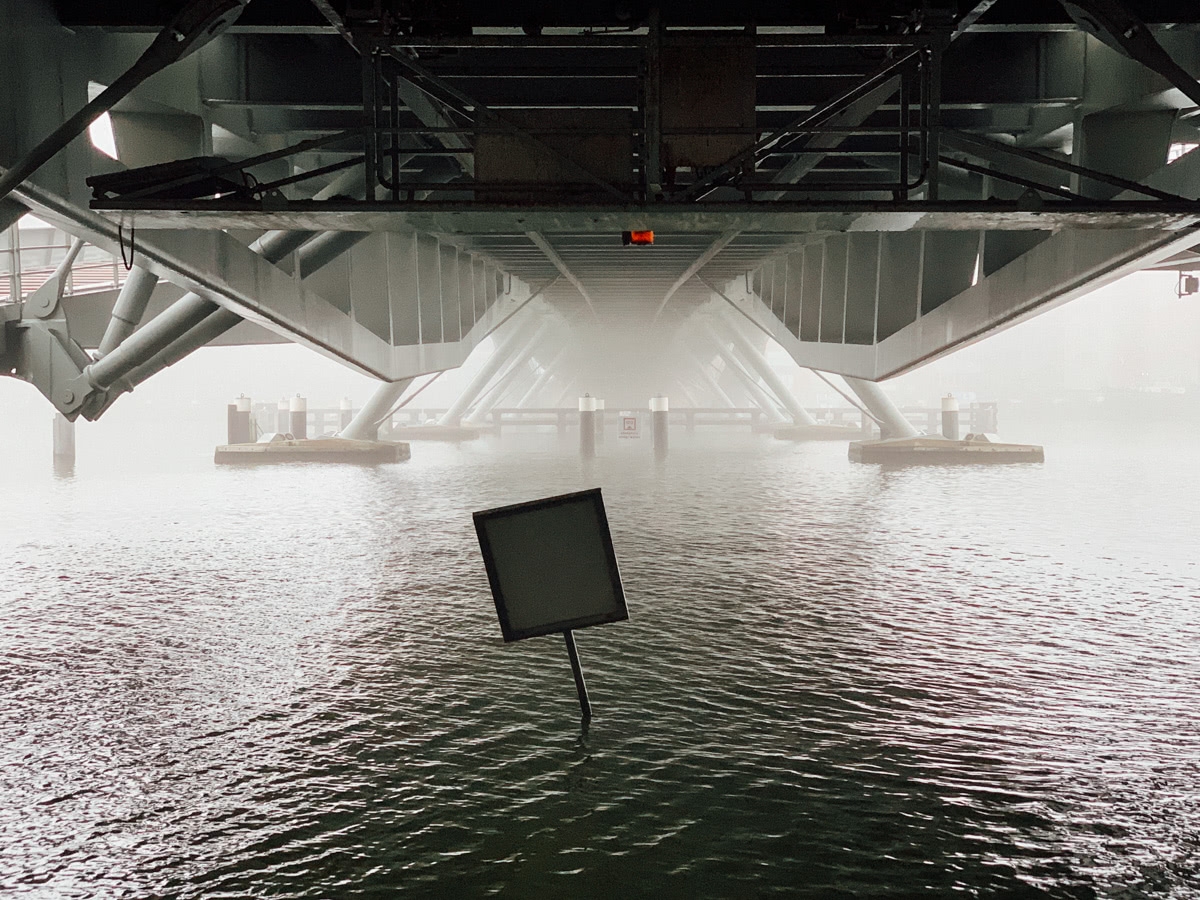 Under Jan Schaefferbrug
Under Jan Schaefferbrug
London Redux
More pictures from the trip to London.
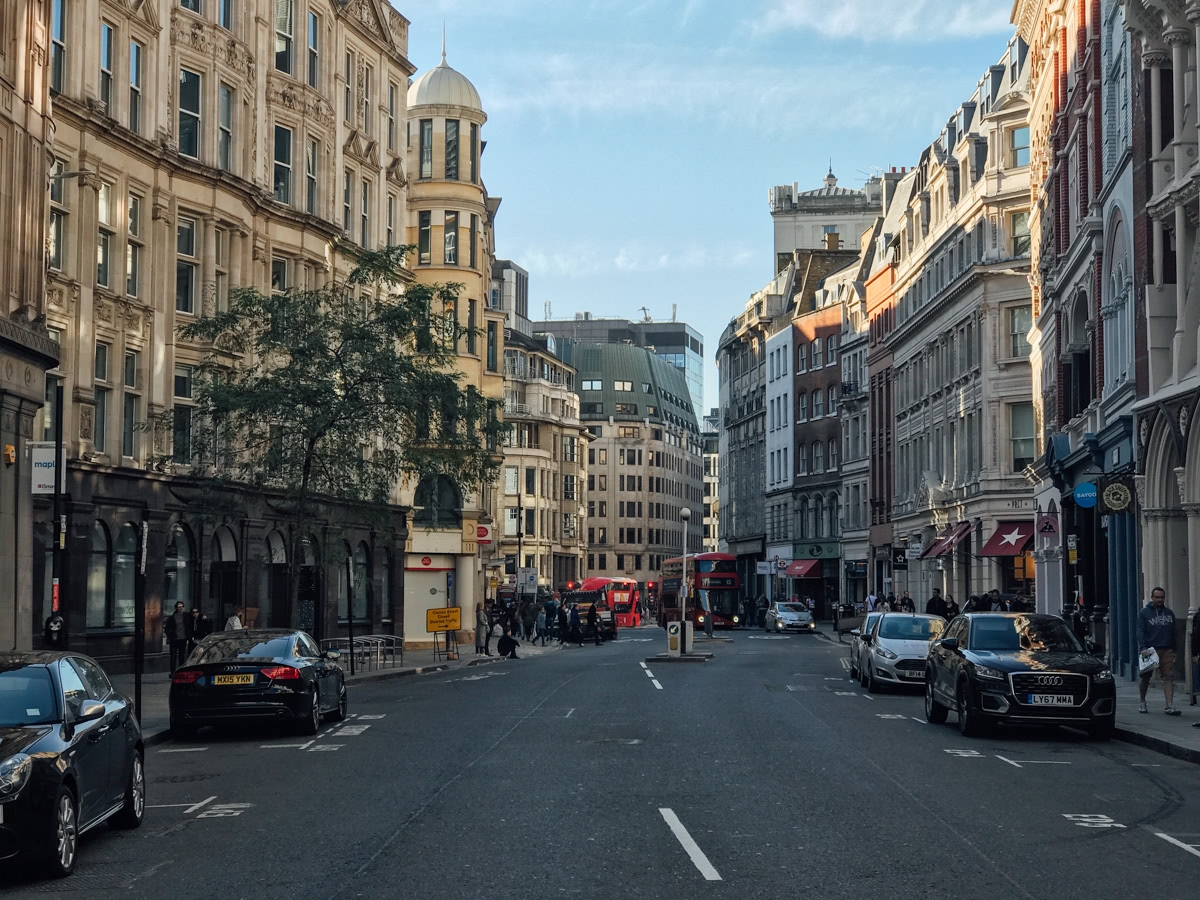 Around Eastchap
Around Eastchap
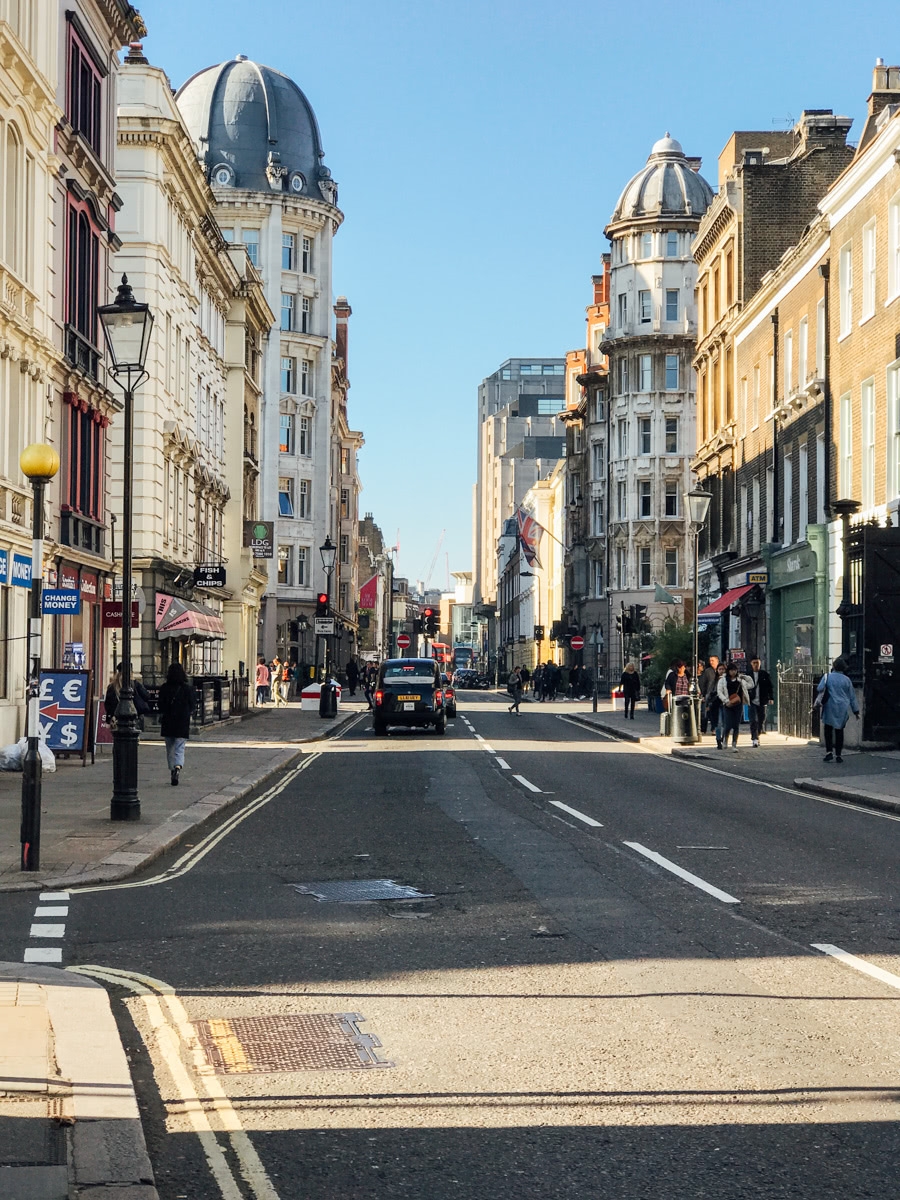 Great Russell Street
Great Russell Street
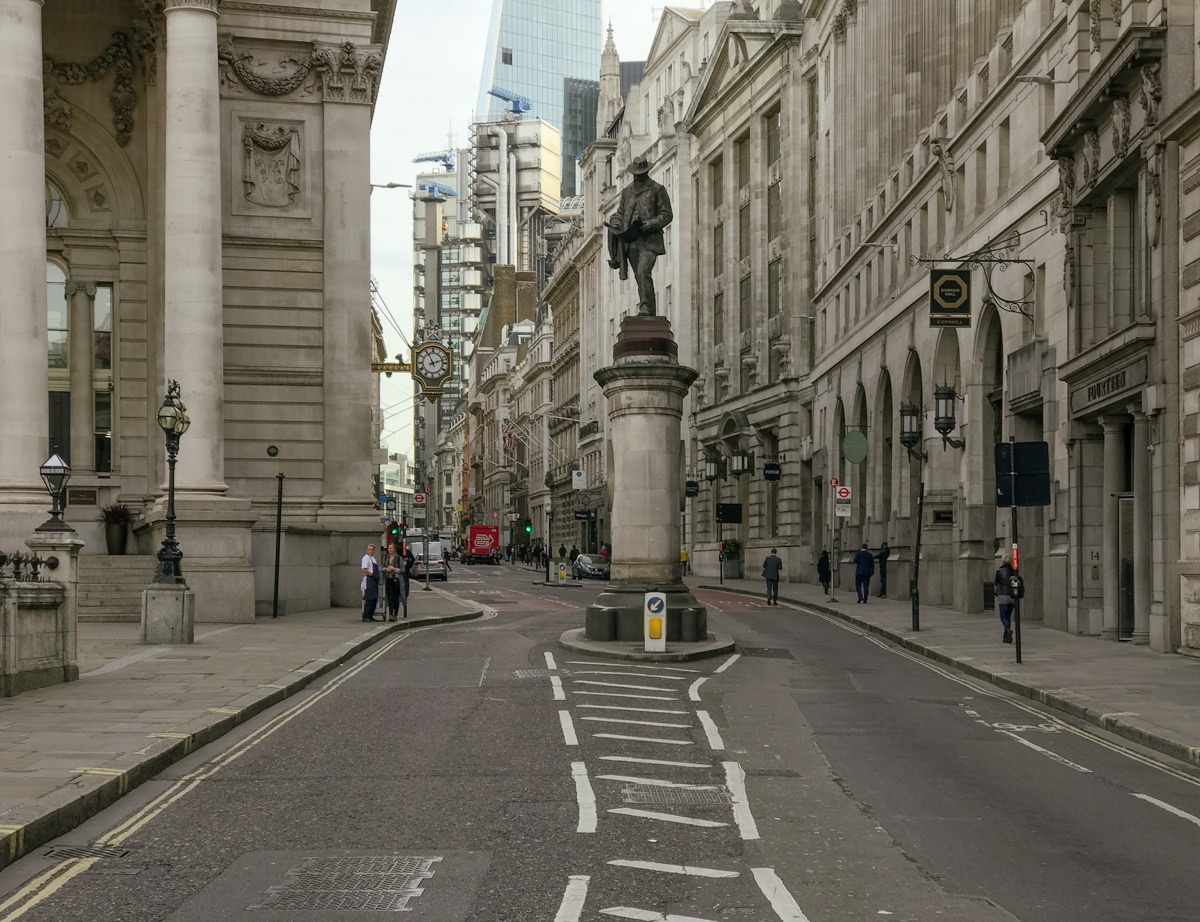 J H Greathead
J H Greathead
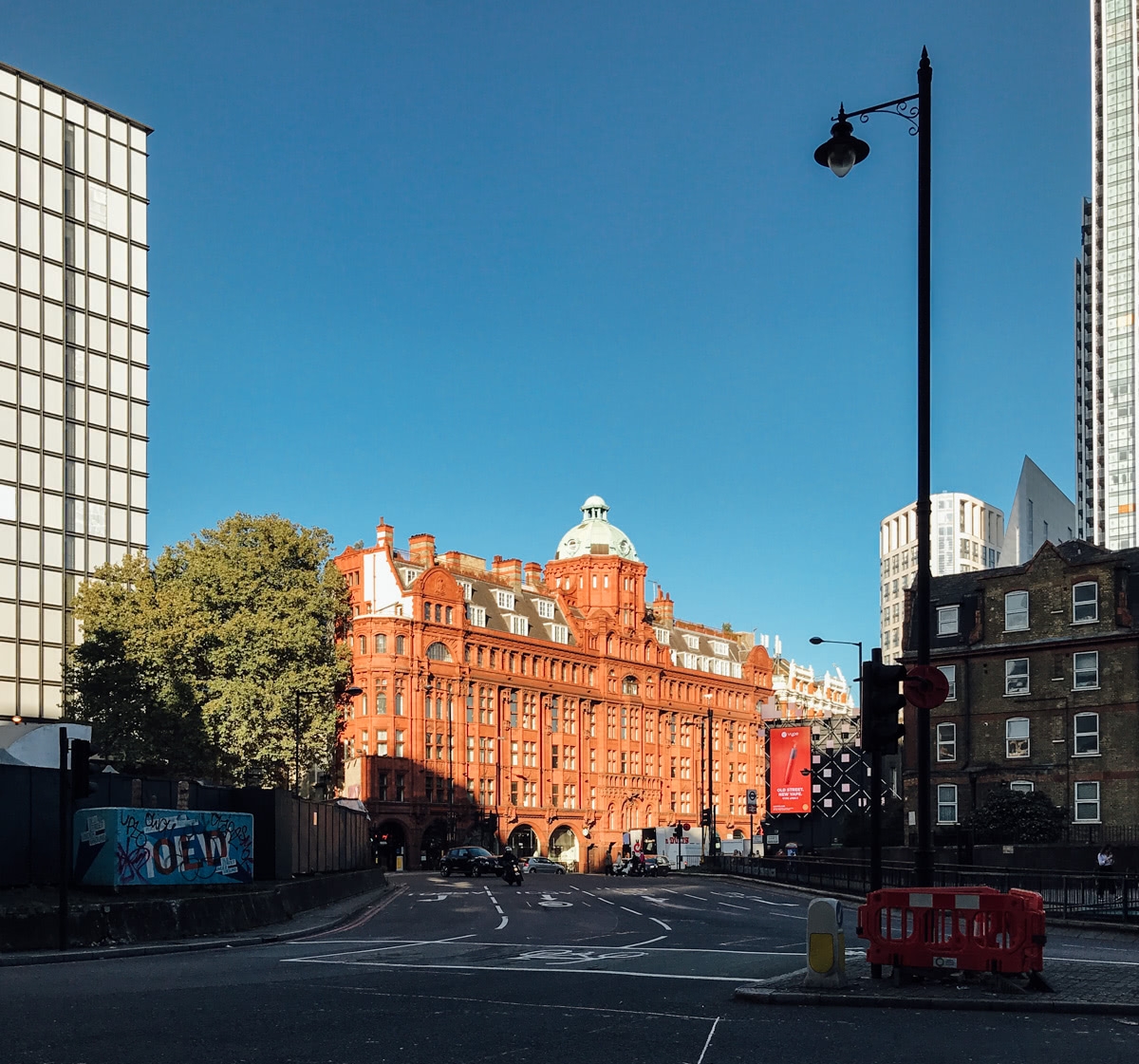 Near Old Street
Near Old Street
 Surveillance City
Surveillance City
London
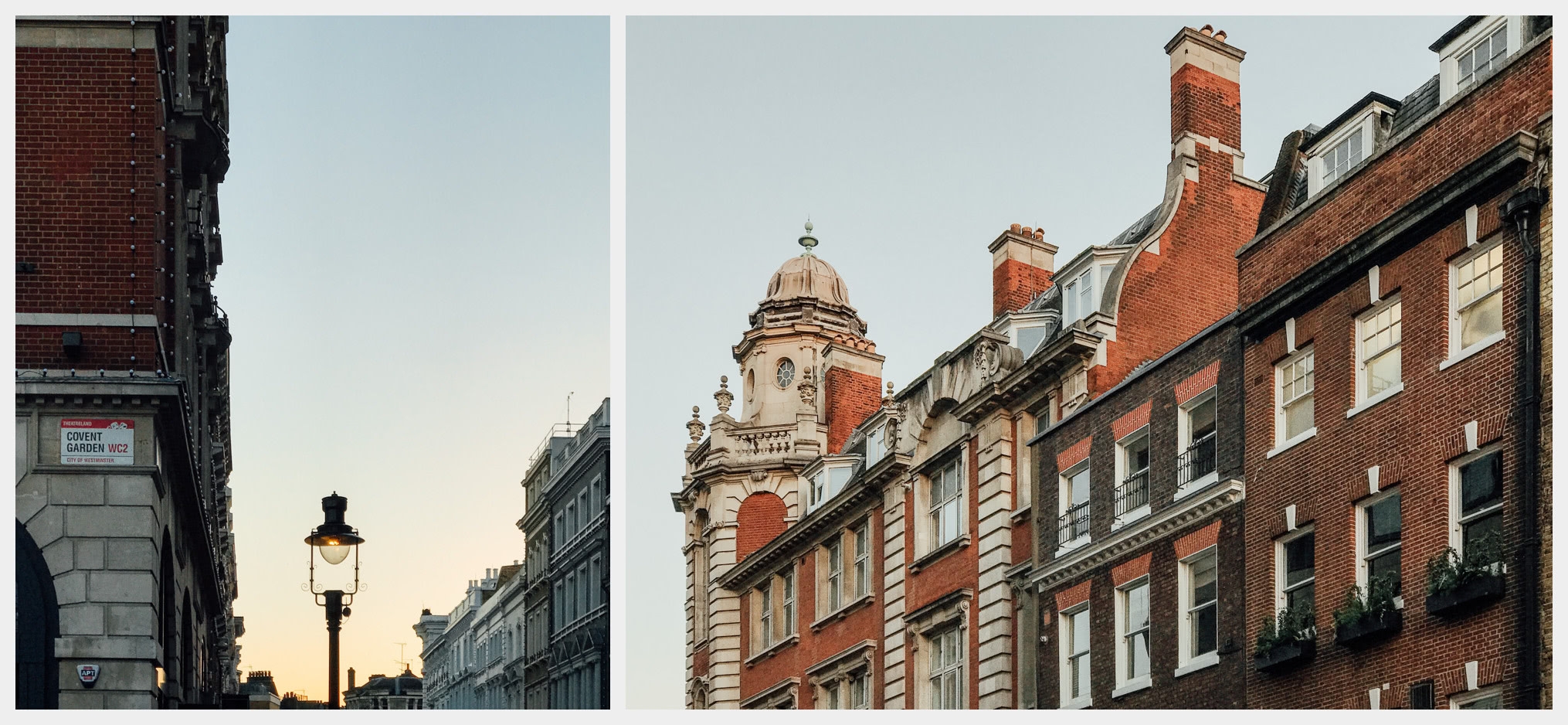 Covent Garden
Covent Garden
From time to time, Pathé Tuchinski in Amsterdam screens plays live from the UK. A recent production of King Lear, with Ian McKellen in the lead role, left us wanting more. It just so happens that Royal Shakespeare Company were staging a production of Macbeth at the Barbican and that was excuse enough for us to plan a trip to London.
Some observations and pictures from the trip in no particular order:
This was the first time we were flying to the Gatwick Airport. Getting to the city center involves a train ride from the Gatwick Airport railway station. We were a bit taken aback by how crowded the station and the platforms were. The trains were packed too - not quite Tokyo rush-hour full - but close enough. The first day of our trip happened to coincide with a protest march in London demanding a “people’s vote” against Brexit. Guardian reports that over 600.000 people took part. That was the reason for the rush and the unusual number of placards per capita.
The announcements at the station kept reminding us to report any suspicious person, object or activity. They ended it with this catchy alliteration: See it. Say it. Sorted. At one of the newly renovated stations, the gate read: Reimagined. Renovated. Reopened. or some combination of three R words with similar import. A sparkling water advertisement at a bus stop read: Beautifully Balanced Bubbles. Is there a new law in UK that requires all copy to be distilled down to a pithy three word alliteration?
The traffic in London seemed a bit out of hand this year. The meagre number of electric cars I saw was quite dismaying too.
Having lived in Amsterdam, I find the lack of proper cycling infrastructure in cities like London quite baffling. It isn’t stopping a few brave souls from trying to cycle though. I had my heart in mouth each time I’d see a cyclist sharing the road with cars, lorries and double decker buses. Some rudimentary laning for cyclists is beginning to take shape in some parts of London but it all seems put together in a very desultory way.
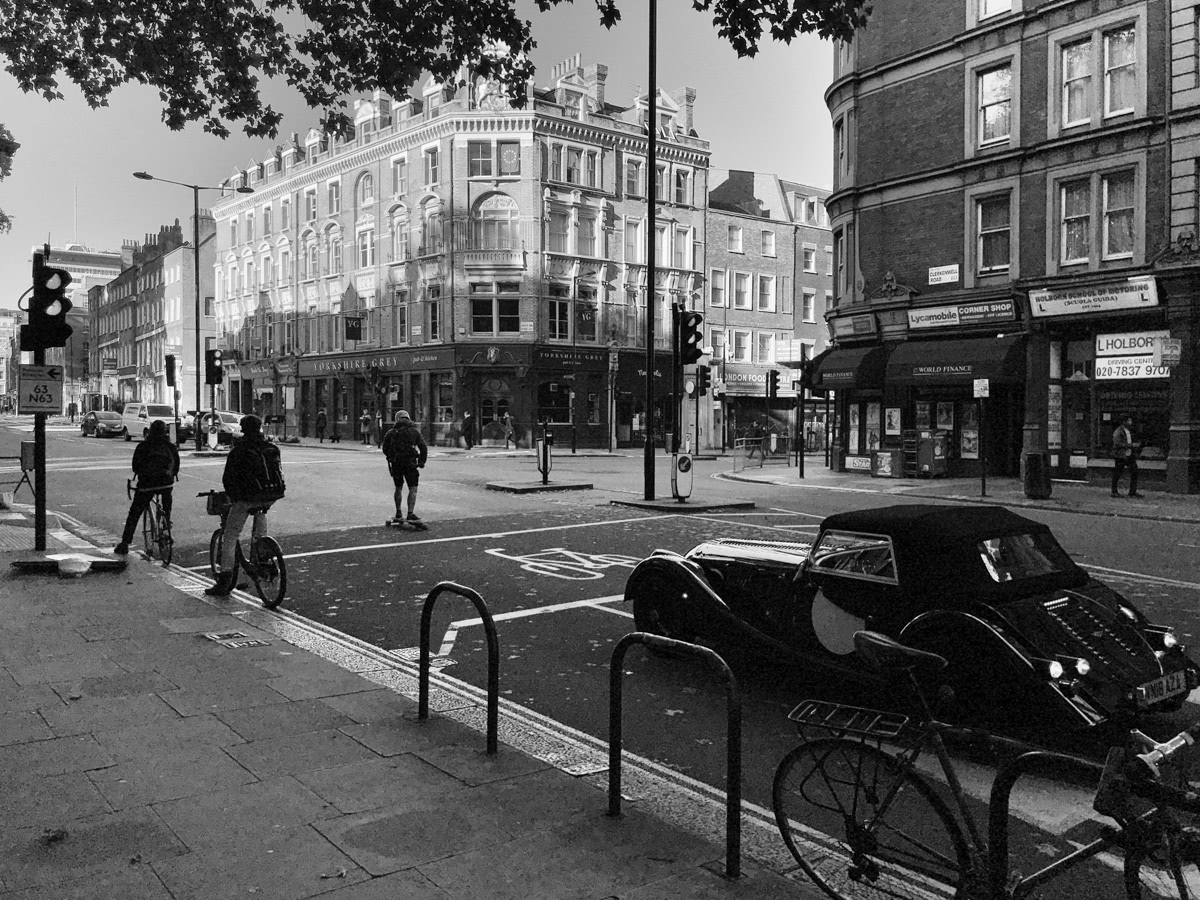 Cyclists and a vintage car wait at a crossing
Cyclists and a vintage car wait at a crossing
That said, public transport in London in simply amazing. The network of buses and metro1 must surely be one of the best in the world. And it’s definitely cheaper than here in Amsterdam. While we have a couple of Oyster public transport cards we always carry on our visits to the UK, we were surprised to find that our contactless Dutch bank cards worked as transport cards in metro, rail and buses. The charges would be debited from our accounts in Euros the next day. Though on a couple of occasions I had trouble swiping in with one of my cards and the wife with one of hers. So on the whole, as a foreign visitor, it’s still worth having an Oyster card on hand.
Another thing that baffles me about a city the size and density of London is the number of ongoing large construction projects in the city center and beyond2. In central London, glass and metal skyscrapers already loom over streets comprised of squatter, more historic buildings.
 Construction cranes
Construction cranes
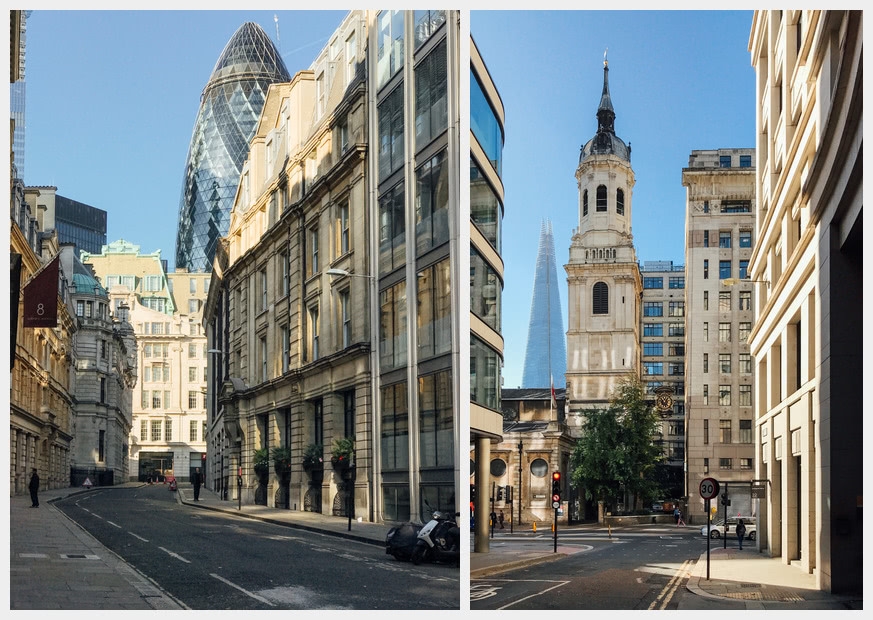 Skyscrapers looming over streets
Skyscrapers looming over streets
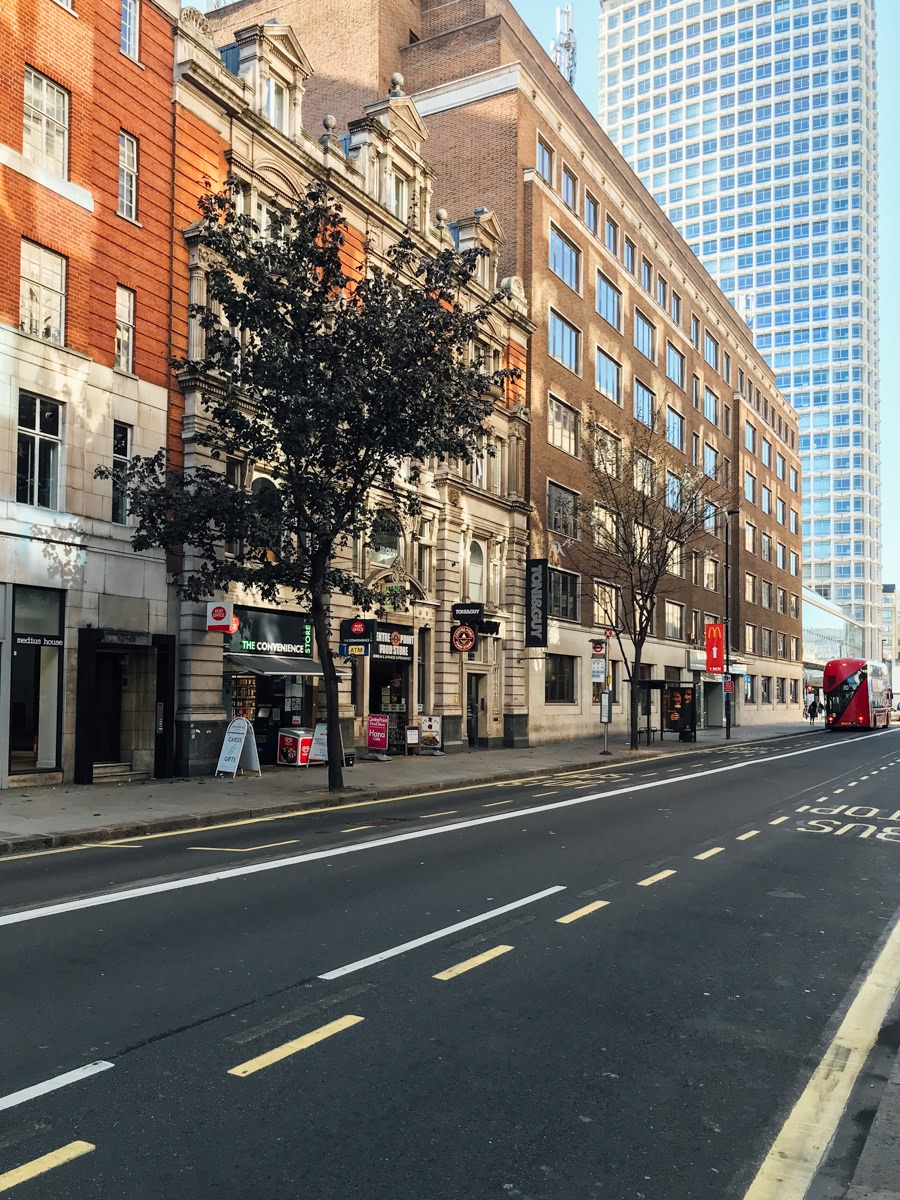 Skyscrapers looming over a street
Skyscrapers looming over a street
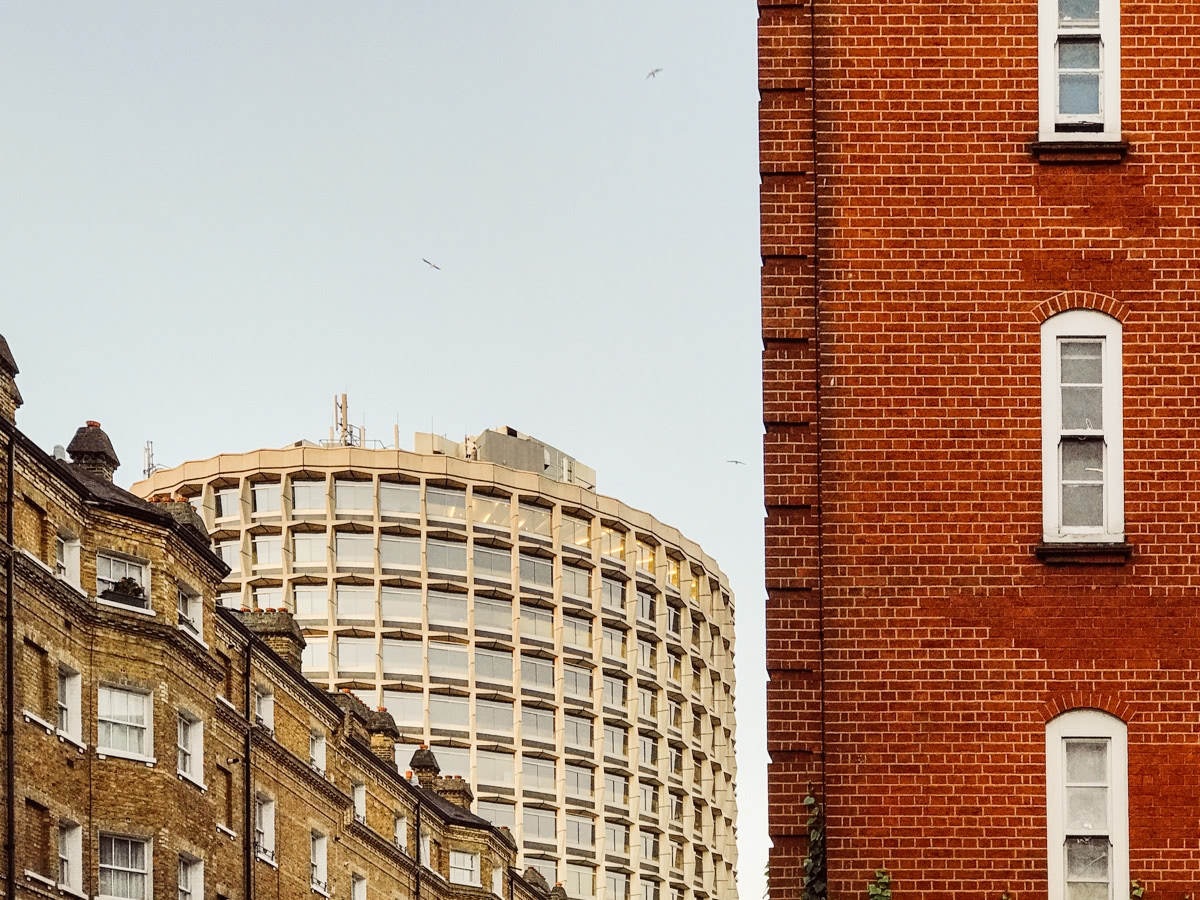 The old and the not so new
The old and the not so new
In some of those streets, I felt a little claustrophobic.
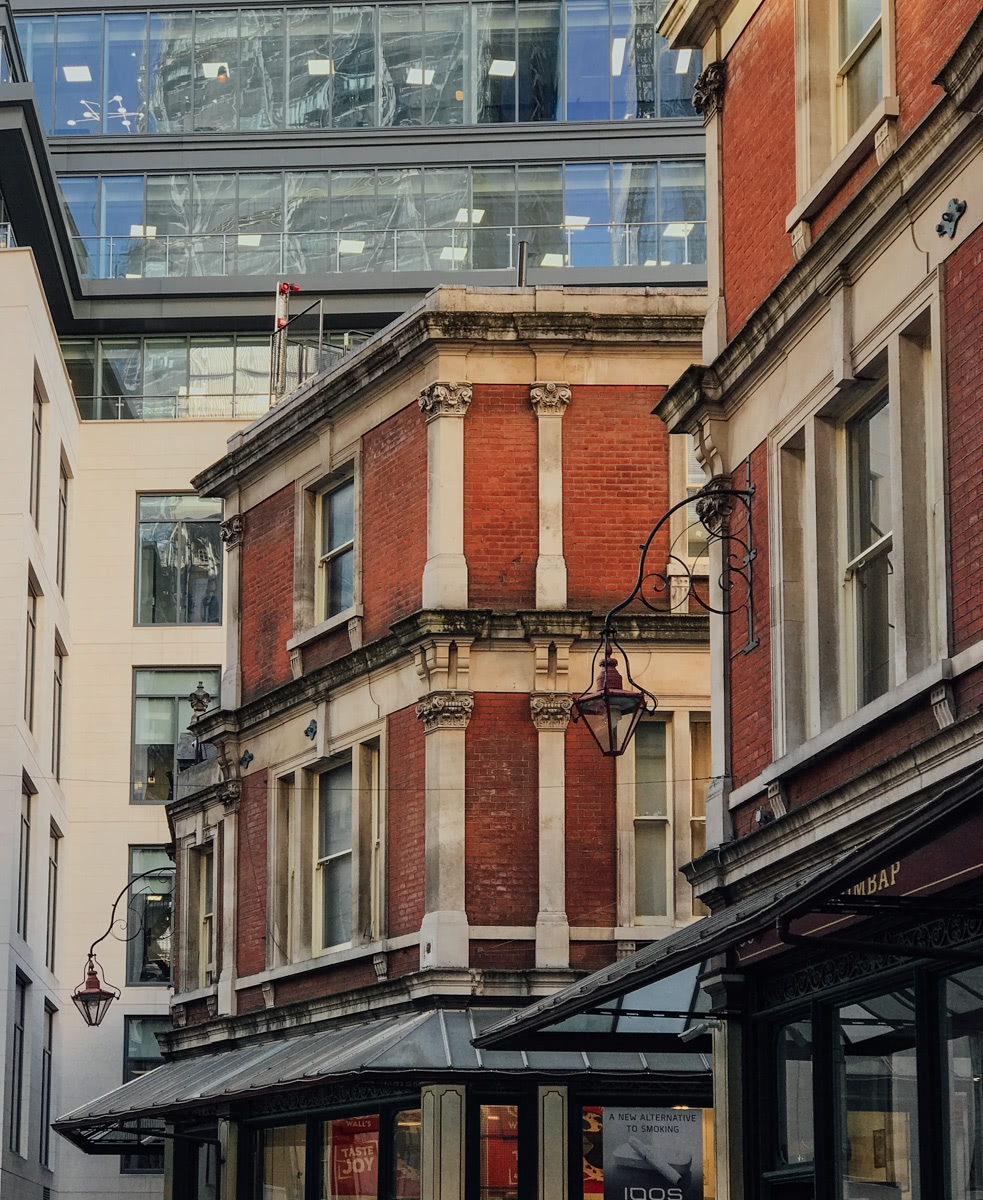 Claustrophobic
Claustrophobic
Came across some incredible graffiti across London, especially at Brick Lane. This one could be a commentary on global warming, or simply an endorsement of the curry restaurant next door:
 Head on fire
Head on fire
Entry to most museums in London is free. We allotted a good chunk of our time to them on this visit. One lazy evening at the hotel, BBC was showing a documentary of some celebrity from the 1970s who had climbed Nelson’s Column in Trafalgar Square. We had tuned into it and soon I had fallen asleep. On emerging from National Gallery, thanks to remembered fragments of footage from the documentary, Nelson’s Column seemed to loom even higher.
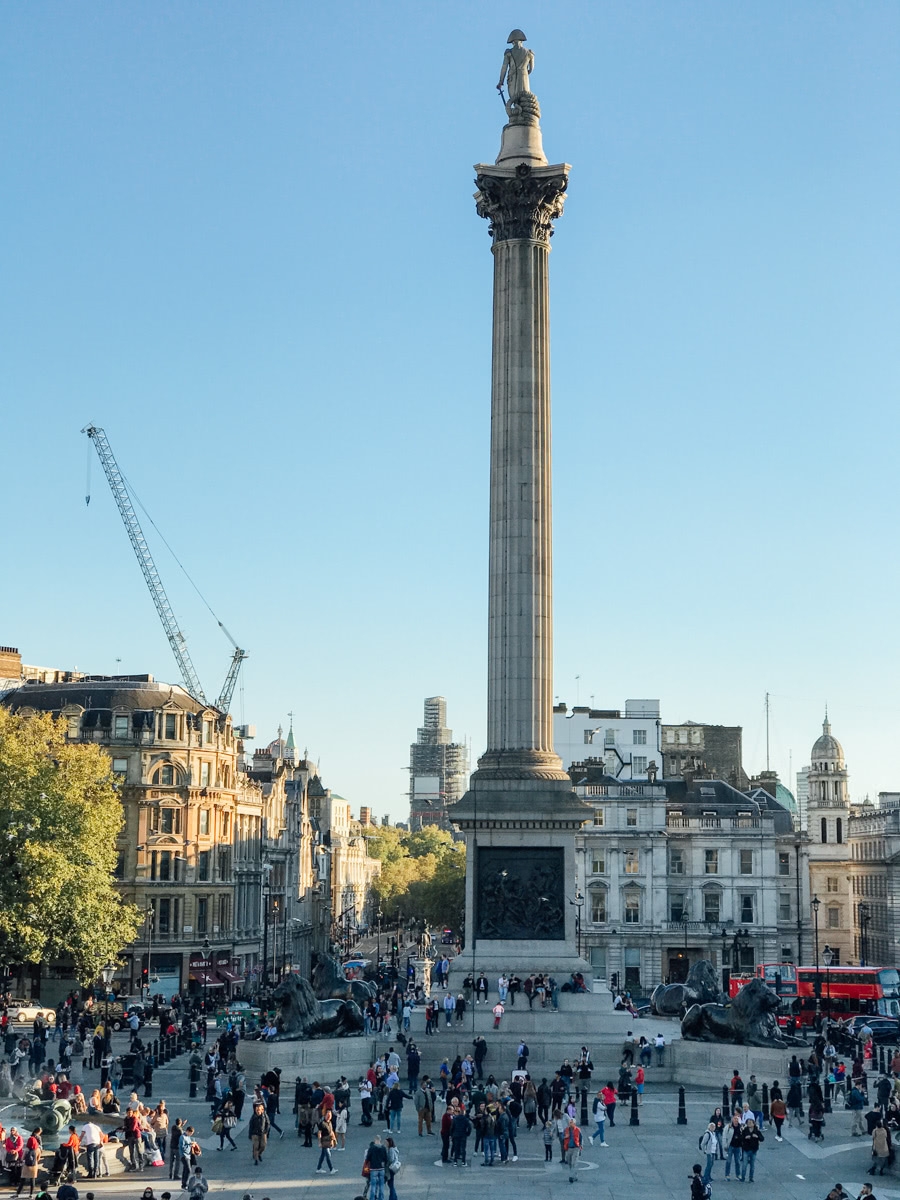 Nelson’s Column and Trafalgar Square
Nelson’s Column and Trafalgar Square
We enjoyed the production of Macbeth we were here for3. All the Shakespeare productions I’ve seen in the last three years, tend to dress the cast in present-day costumes. They also make use of present-day props. They don’t carry this all the way through. For example, Macbeth might wear a camouflage military jacket, but he’d still fight with a sword. I find this jarring. The wife isn’t as bothered. She reminded me that the setting of many Shakespearean plays, predates their first performance by several centuries. So the ‘original’ costumes were 17-th century British impression of an era several hundred years before, i.e. quite anachronistic to begin with. And if we wanted to uphold the original performances as the gold standard, women wouldn’t be cast. She has a point.
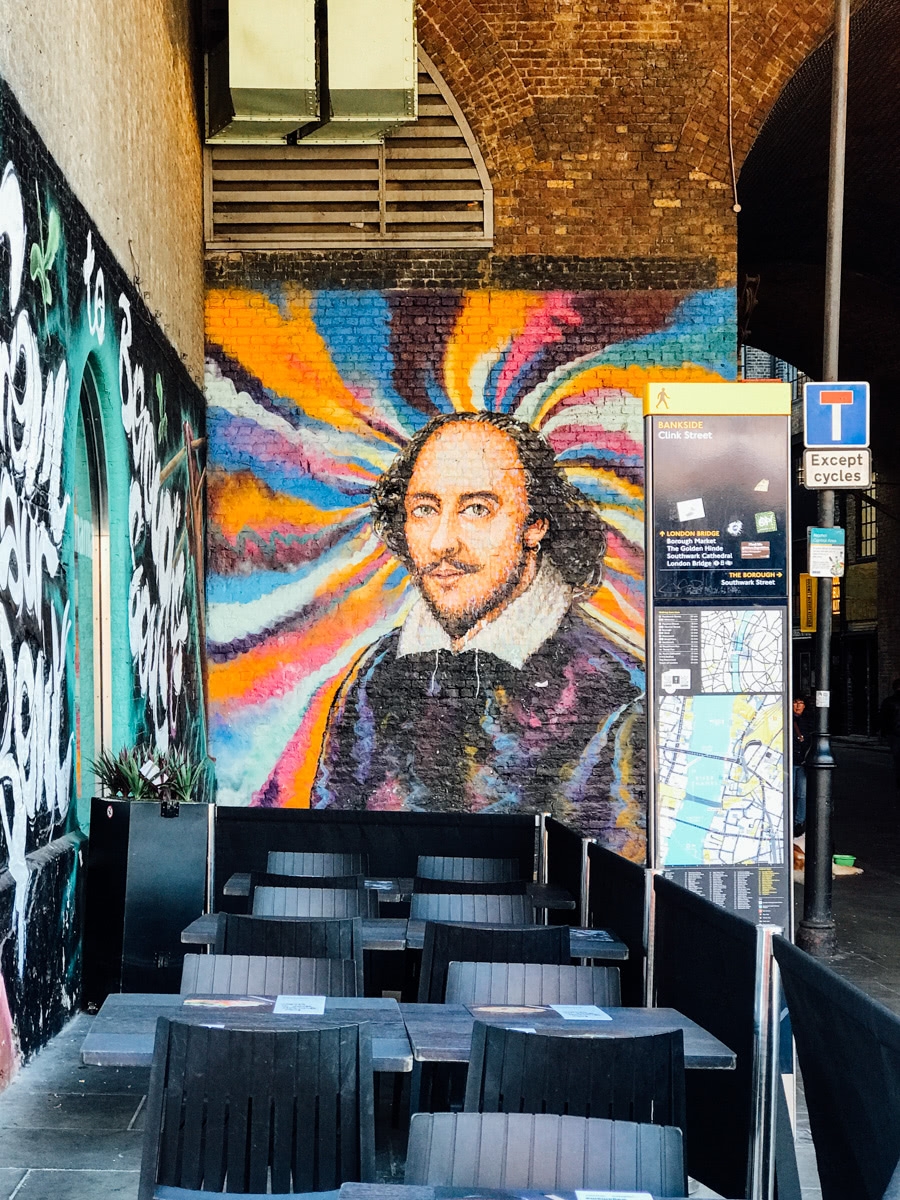 Shakespeare
Shakespeare
Even in this age of selfies, people occasionally ask you to take a picture of them with their cellphone. There is something quintessentailly quaint and human about it that I find endearing. Anyway, this old couple who stopped me to take a picture of them on London Bridge, had their iPhone set to take picture in Live mode4. Which means all my prompts to smile were duly recorded along with the pictures. Strangers you ask to take your pictures, cease to exist the moments after they’ve handed you your phone or camera back. In this instance, my voice will travel with them and become a part of their holiday album.
We left London on an afternoon on a working day. With no scheduled protest marches or morning rush hour traffic, the stations exuded an air of leisurely calm. Even the train announcements sounded like commentary for a test match headed for a certain draw about to break for tea on the 5th day.
I love how easy it is now to visit London. I hope that Brexit doesn’t cause UK to erect bureaucratic hurdles that make it harder for people from continental Europe to visit. That said, I am not counting on the free of charge mobile roaming between EU and UK to continue working after Brexit.
It was unseasonably warm during our visit in October, but the metros felt like they were still reeling under this summer’s heat-wave. I was reminded of this article about the Transport For London project to cool down the London Metro tunnels.↩︎
And not everything is being built upwards.↩︎
The play was at the Barbican Center. Personally, I am not a fan of the Barbican. They call this architecture brutalist but my private term for it is mirthless.↩︎
Live mode records a few seconds of audio and video before and after the picture is taken.↩︎
Autumn Light
It’s been an unusually warm and sunny Autumn in Amsterdam. Still, the shortness of the days is now quite noticeable. The sun stays quite low in the sky. The light seems to take on a different texture. The shadows are somehow more pronounced. Anything that the sunlight touches feels ablaze.
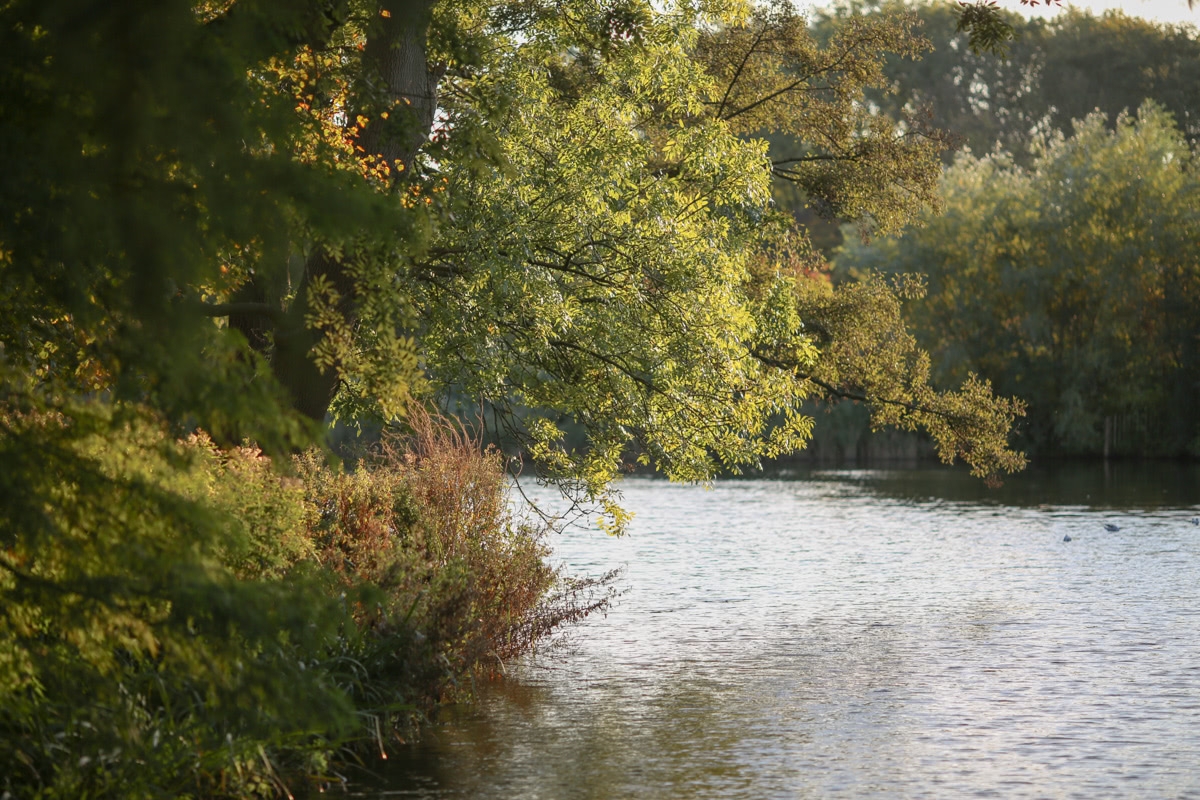 Dusk
Dusk
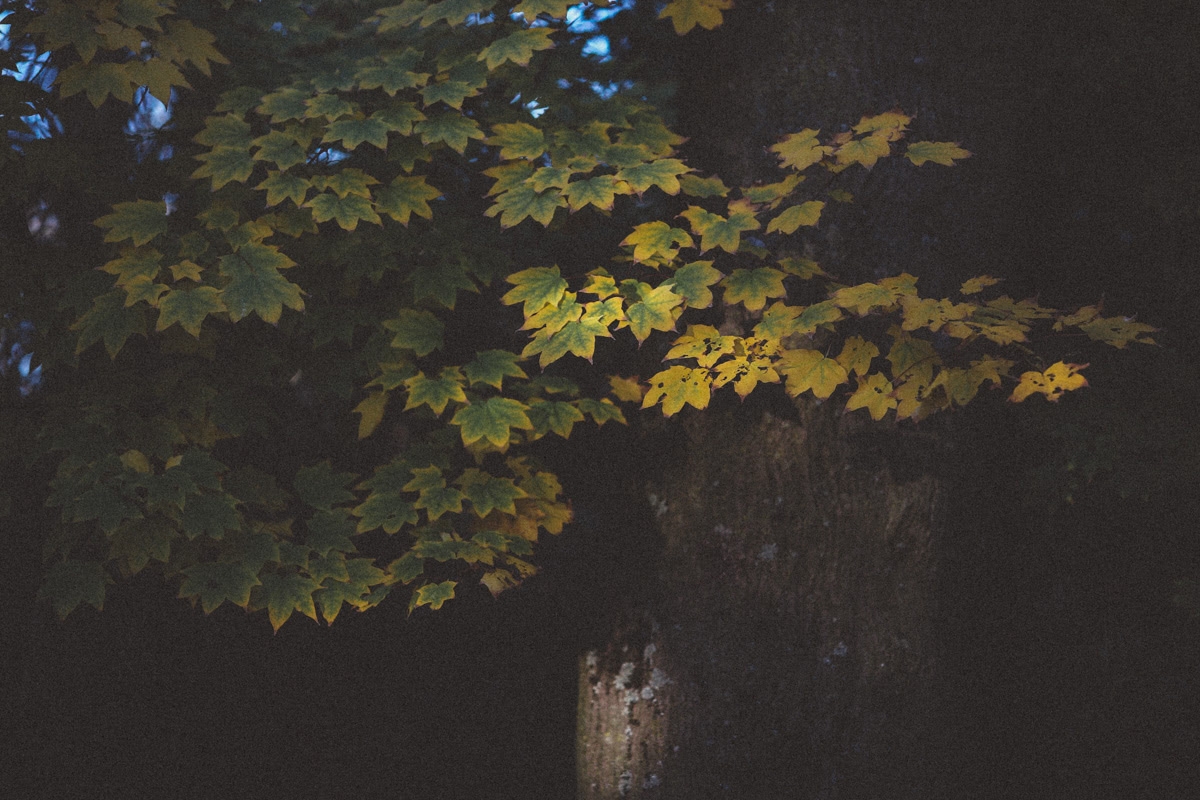 Shadow
Shadow
 Fall Colours
Fall Colours
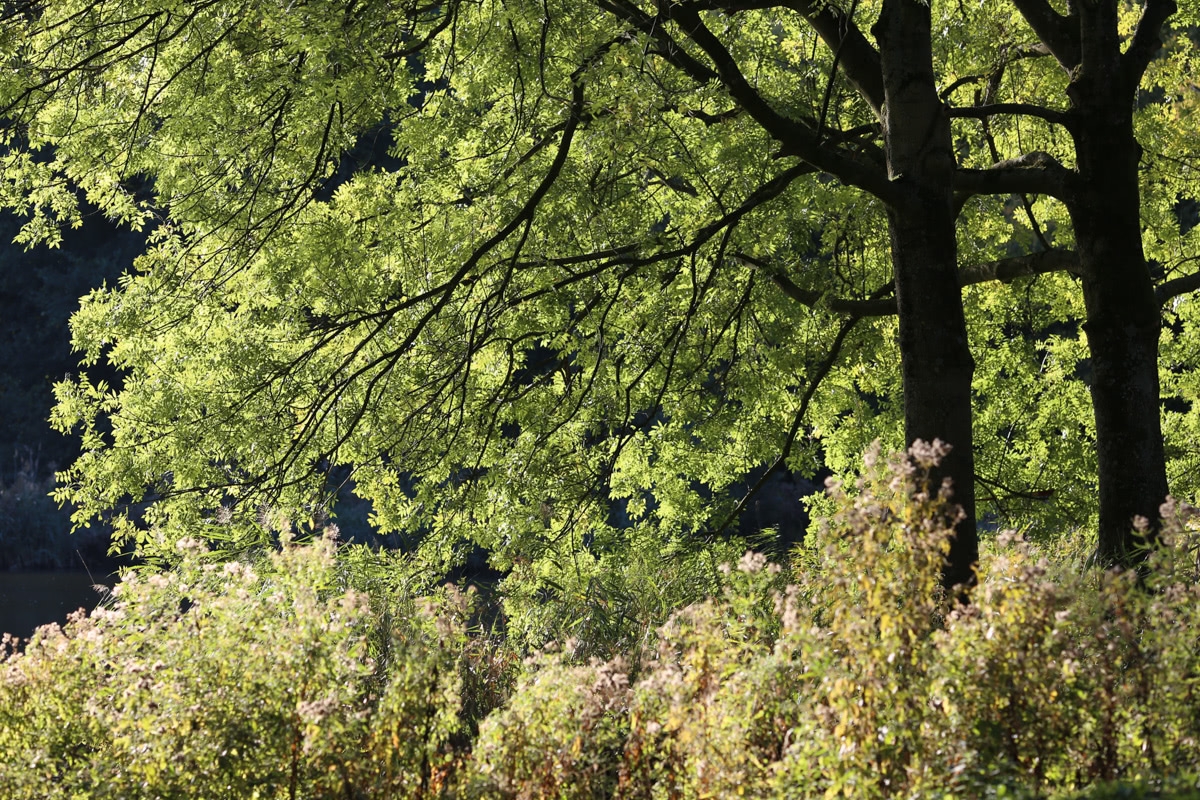 Ablaze
Ablaze
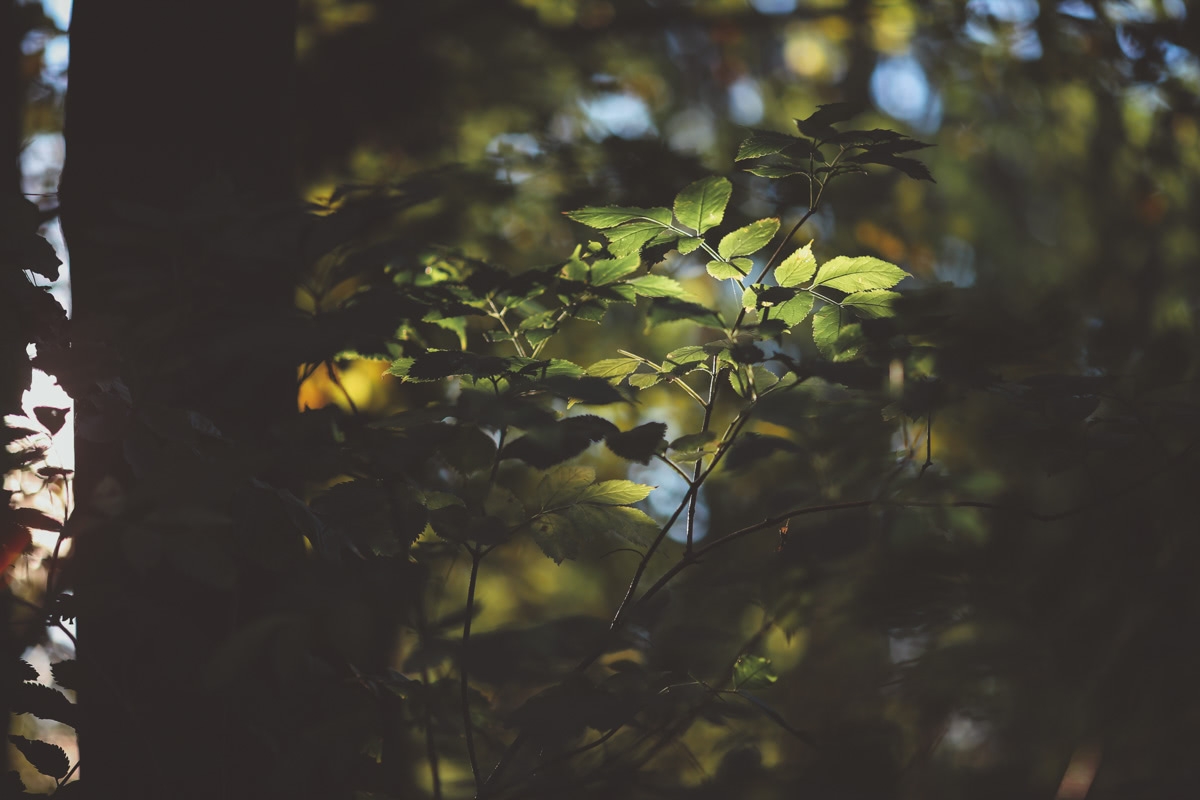 Light
Light
A personal history of video games
I still vividly remember the first time I saw a video game. I was in grade 6 or 7 when the whole class of 40 or so pupils was ushered into the newly built computer lab. We had to take our shoes off before entering the room - purportedly to keep the lab dust free. The only place I had seen with many shoes outside before was a temple. There were some 10-15 computers, mostly PC-XTs, on tables arranged in a U-shape. The machines had no hard disks. Two teachers started at each end of the U and loaded DOS and a game called Bricks on our computers using 51⁄4 inch floppy disks. We sat three to a computer. One person took charge of moving the pedal left, one for moving it right and one for releasing the ball.
Other games I remember from that era:
Alley Cat
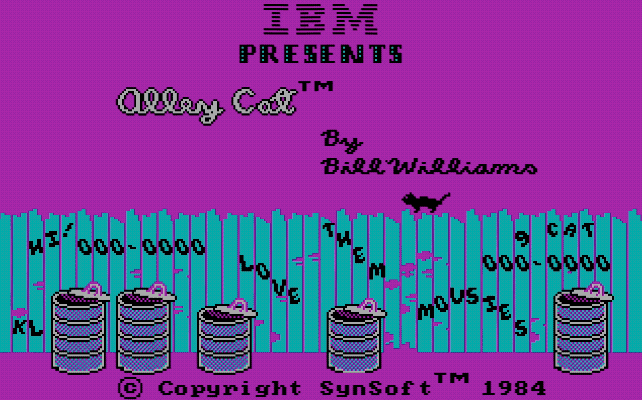 Alley Cat
Alley Cat
Bouncing Babies
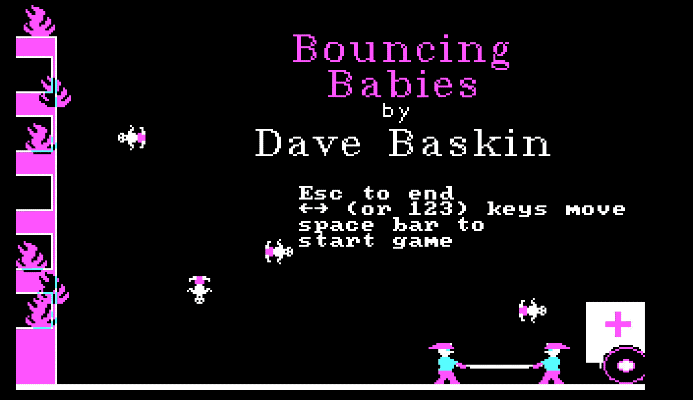 Bouncing Babies
Bouncing Babies
Paratroopers
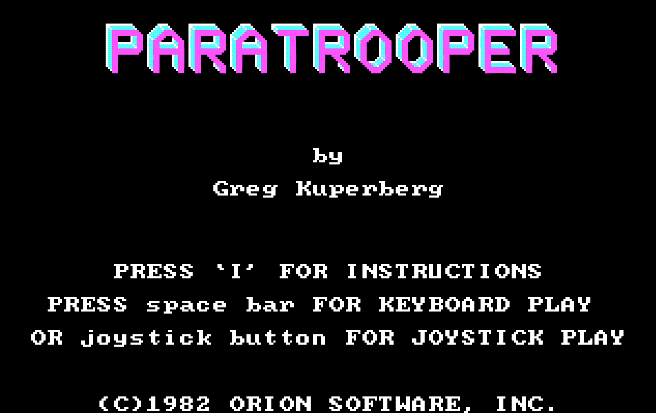 Paratroopers
Paratroopers
All played on the radium-green or ember glow of monochrome monitors.
Most neighbourhoods in Delhi had a video library (or “video parlour” as these establishments were colloquially referred to). India’s middle class was still nascent. Most households didn’t have a colour TV, let alone a video cassette player. So these libraries would lend you not only the movies, but also the video player. You’d stand outside the store, browse through a catalog of usually handwritten pages bound in a file or a notebook, see if they still had a player available for rent, and ask them to deliver it to your home. It was common to have relatives over for a movie night on Saturday. The guys (always two, one to drive the scooter the other to hold the video player) from the video library would come in at the designated time, install the video player and leave1. They’d come back in the morning to collect the player, video cassettes and their payment.
As the middle class grew in affluence, colour TVs and video cassette players found their way into Indian homes2. The video libraries still rented the video players, but it was now mostly a video cassette lending business. Even the local grocery stores would try to supplement their income by keeping a small stock of popular films. One of these enterprising neighbourhood video libraries got hold of an Atari console and hooked it up to a TV inside their shop. For a mere 50 paise, you could go in, sit on a chair and play a game till your video game character used up all its lives. At night, they’d rent the console out for a princely sum of 15 Rupees.
I didn’t have a religious upbringing but on the nights we’d rent the console, I’d be praying hard to a favourite God or two from the Hindu pantheon to prevent power cuts3. The console would have two controls so my sister and I would play against each other for games that’s allow it - like Boxing, or take turns for games that wouldn’t - like River Raid.
My mom would briefly join us, but was usually more content to watch us play. Dad would be mostly unimpressed about the whole affair and would just retire to bed as usual. We weren’t allowed to stay up past 1:00 AM. Waking up early is looked at as being more virtuous in Indian culture than staying up late. I’d set an alarm for 5:00 AM, get up, brush my teeth and play till the duo from the video library would show up to collect their wares.
I still remember that Atari cartridges had physical switches (jumpers?) that you’d toggle to change the game. The instructions were sparse and there was no Internet to guide you, but most games were simple and you’d figure them out by trial and error. Some games that I still remember:
Boxing (and the top-down view of the boxers!)
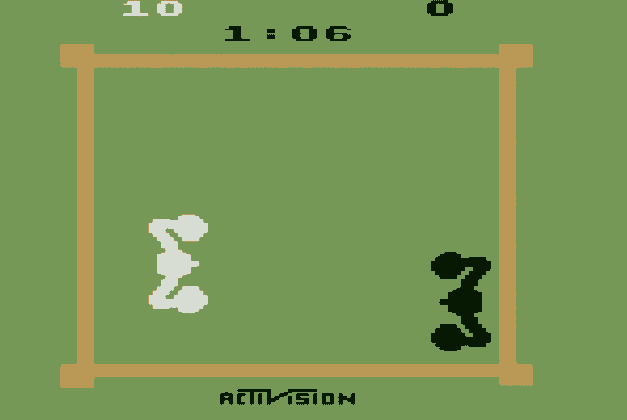 Boxing
Boxing
River Raid
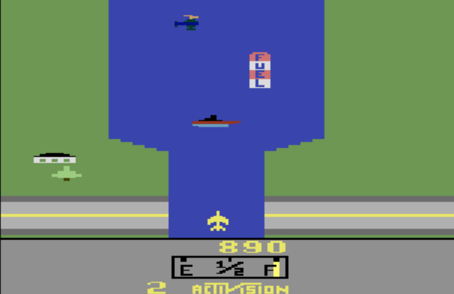 River Raid
River Raid
Frogger
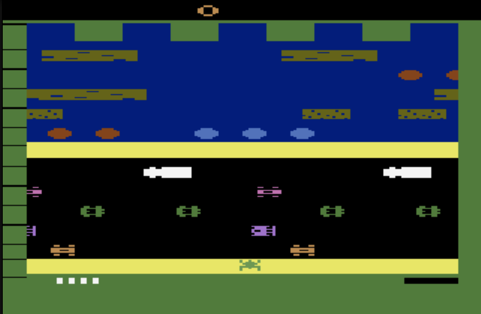 Frogger
Frogger
Eventually the video libraries graduated to the Nintendo console. Coming from Atari this was a much more colourful and intricate world. It was like watching an animation film and being in control of it. At 30 Rupees for a night, it was also twice as expensive to rent as the Atari console. In the beginning, a cartridge had just one game. I remember the cartridges as being bigger and heavier. I remember how warm they’d be when they’d come out of the console. But most of all, I remember how sore my thumbs would be the next day from all the jabbing at the buttons of the controllers. The first time we rented one, we got two cartridges: Mario Brothers and Contra. We must’ve played Mario 75% of the time4.
This was the time when the first video game arcades with coin operated machines started springing up in our neighbourhood. My Dad took me to one where I was more than happy to watch other kids play. Kung-Fu Master and Zippy Race were a favourite for many days.
We’d still occasionally rent the Nintendo console from the video library. Other than the next versions of Mario and Contra, the fare now included a multi-game cartridge with on-screen game selection. Excite Bike and Circus were our favourite from this time. The consoles, like video players before them, eventually became affordable. The arcades started to wind down. My parents were (rightfully) concerned about time spent in front of the TV and our studies suffering, so even if we could afford it, we never got one.
At least one make-shift arcade in our neighbourhood (a dingy little room above a radio repair shop accessed by a narrow staircase) laboured on. During school summer vacation, I’d be allowed a small allowance to spend on playing video games and I’d spend practically all of it on Adventure Island.
By this time, most kids had mastered the games and could finish them without their on-screen character losing lives. Arcades like this one, had to install timer circuits. For 50 paise, you could play for 10 minutes. If you lost your lives before the time, the game ended as usual, but if you did not, you’d need to fork 50 paise for another 10 minute of play.5.
During early 90s, I wasn’t aware of any video game arcades in our neighbourhood. A slightly up-market neighbourhood nearby; which I’d visit to study at a friend’s house, still had one. They had upgraded their machines to SNES so I got to experience the next generation of video game graphics through Street Fighter and Final Fight.
Since about 1995, whatever little gaming I’ve done, I’ve done on a PC (and lately on an iPhone). To write about my favourite games from this time would take a post of its own.
Those days of rented game consoles, and visiting arcades feel so distant that they could’ve been someone else’s life. What got me recounting those days was a recent visit to a Virtual Reality gaming arcade in Amsterdam.
Within a minute of wearing the VR headset, my mind adjusted to the new reality and forgot the world outside. The first demo involved taking an elevator to the top floor of a high-rise and walking on a narrow plank. To accentuate the illusion, the employees at the arcade place a wooden plank in front of you - they needn’t have bothered. When I fell off the edge of the plank, I bent on my knees to brace for the fall. Morpheus’s words from The Matrix had never rung so true before: “Your mind makes it real”6.
There were other games too - perhaps it’d be more appropriate to refer to them as other worlds that my mind momentarily inhabited. In one you’d use a jet pack to fly and douse fires on the roofs of high rises, in another you are an Elf archer, defending your hold against hordes of marauding trolls and orcs. They’d occasionally throw a spear or axe your way, which you’d dodge by moving out of its way. While the games were played with two controller “sticks” - one in each hand - the act of moving your entire body to some end, say to dodge something thrown at you, made the virtual worlds seem all the more real. I ended the session with the VR version of a 2001 game I used to play on PC - Serious Sam. Despite the relatively low quality (by today’s standards) of graphics those worlds had felt utterly real even 17 years ago. To be placed inside the same world more than a decade and a half later felt exhilarating!
I am quite convinced that VR will touch many areas of our future lives. While gaming and entertainment are leading the charge, I now feel that the VR meeting demos we’ve been seeing online will be the next to go mainstream, especially in scenarios where members of your team are spread across different locations. And I can probably not even imagine the applications that the next generation that grows up on VR will dream of.7
What a time to be alive.
Sometimes, if your movie night included a new movie in high demand, they’d even drop by to fast forward the songs. Songs in Bollywood movies can be 5-10 minutes long and usually do little to move the story forward. This way the movie could be made to finish 30 minutes in advanced and the tape handed over to the next customer.↩︎
Akai and Panasonic were coveted brands. There existed a class hierarchy of sorts: families that could afford video cassette players and those that could afford video cassette recoreder.↩︎
Delhi had a notoriously unreliable power grid. Long power cuts, both scheduled and unscheduled lasting hours were quite common in our neighbourhood, especially in summers.↩︎
Both my sister and I weren’t particularly good at it. World 1x3 is mostly where things would end and yet we were somehow never bored. I discovered “warp zones” much later by watching other kids play in the arcade.↩︎
While writing this post, I discovered a fascinating sub-culture dedicated to finishing the original Mario Bros. as fast as you can. The current record - involving warp zones and then some serious tricks on top - is 4 minute, 30 second. So a 10 minute limit for a “speed run” is generous, but feels too strict if you want laid back enjoyment of the game.↩︎
Google Cardboard is the closest I had come to experiencing Virtual Reality before this visit so I knew that the illusion of being elsewhere can be powerful. But I soon realised that Google Cardboard, nifty as it is, is a poor substitute for a real headset. It bothers me how little a stimulus your mind needs to interpret it as reality. Millions of years of evolution is overwhelmed by a handful of decades worth of invention.↩︎
The futuristic world of Ready Player One suddenly seemed all the more plausible.↩︎